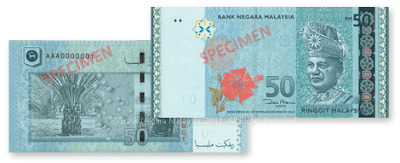The New Series of Malaysian Banknotes
The latest series of Malaysian banknotes draws its inspiration from elements which distinctively define the country's diverse culture, heritage and nature. Themed 'Distinctively Malaysia', the fourth series of Malaysian banknotes features traditional expressions in the art and craft, natural wonders, flora and fauna, economy and tradition.
Common Features
On the obverse side, all banknote denominations in the new series retain the portrait of the first Seri Paduka Baginda Yang di-Pertuan Agong, Tuanku Abdul Rahman ibni Tuanku Muhammad, the national flower Rosa-sinensis hibiscus (known locally as the 'Bunga Raya') and patterns of traditional woven fabric - the 'songket'.
The reverse side of each banknote denomination features different elements of nature, tradition, culture, flora, fauna and the economy that are distinctively Malaysian.
Technical Specifications
|
Denomination
|
Substrate
|
Denomination
|
Predominant Colour
|
|
RM100
|
Paper
|
150mm
X 69mm
|
Purple
|
|
RM50
|
Paper
|
145mm
X 69mm
|
Green-blue
|
|
RM20
|
Paper
|
145mm
X 65mm
|
Orange
|
|
RM10
|
Paper
|
140mm
X 65mm
|
Red
|
|
RM5
|
Polymer
|
135mm
X 65mm
|
Green
|
|
RM1
|
Polymer
|
120mm
X 65mm
|
Blue
|
RM100 banknote
Natural Wonders
The magnificent beauty of Malaysia's two prominent natural wonders, declared 'World Heritage Sites' by the United Nations Educational, Scientific and Cultural Organization (UNESCO) are portrayed on the RM100 banknote.
These are the Kinabalu Park in Sabah, home to the majestic Mount Kinabalu (the highest mountain in Southeast Asia) and the spectacular limestone pinnacle rock formations of Gunung Api valley, found within the Mulu National Park in Sarawak.
Together, they represent the many natural wonders of Malaysia that provides visitors a unique experience.
RM50 banknote
Agriculture and Technology
Oil palm and biotechnology are featured on the RM50 banknote as Malaysia's thriving economy icons. Oil palm has become the country's most valuable agricultural crop as Malaysia is one of the largest producer and exporter of palm oil in the world.
Biotechnology continues to drive this commodity up the value chain, supporting the nation's economic transformation towards higher value-added activities in the agriculture, manufacturing and services sectors of the economy.
Crude palm oil is also used as the underlying commodity to facilitate Islamic financing.
RM20 banknote
Marine Life
As ambassadors of the rich and colourful marine life found in our tropical waters, two of the most well-known species of sea turtles endemic to Malaysian waters are on the new RM20 banknote - the Hawksbill Turtle (Eretmochelys imbricata) and Leatherback Turtle (Dermochelys coriacea).
The Hawksbill is easily identified by its curved beak and scaly shell while the Leatherback has a leathery skin and seven ridges on its shell.
These gentle turtles are a reminder that their existence rests in the delicate balance of human activity and marine life conservation.
RM10 banknote
Flora
Malaysia's lush tropical jungle, which is one of the world's oldest living rainforest, is home to a spectacular variety of flowering plants. Most iconic amongst them is the Rafflesia, the world's largest flower.
The Rafflesia Azlanii species featured on the new RM10 banknote is indigenous to Peninsular Malaysia and was first discovered in the Royal Belum Forest Reserve of the state of Perak in 2003.
To commemorate its discovery, this majestic flower was named after the Sultan of Perak, Sultan Azlan Muhibbuddin Shah ibni Almarhum Sultan Yusuff Izzuddin Shah Ghafarullahu-Lah.
RM5 polymer banknote
Widlife
Featured on the new RM5 polymer banknote is the Rhinoceros Hornbill (Buceros rhinoceros), one of the largest and most magnificent hornbill species in the world.
Found in low densities throughout various rainforests in the country, this beautiful, broad-winged and long-tailed forest bird plays an important role in the customs and traditional ceremonies in Sarawak which is known as 'Bumi Kenyalang' or 'Land of Hornbills'.
Hornbill is also seen as a symbol of strength and courage by the native communities of Sarawak.
RM1 polymer banknote
Traditional Sport
Kite-flying is a popular traditional sport in Malaysia especially in Kelantan and Terengganu. Kite-flying is also traditionally a celebration of a good harvest which brings together the local communities in these states.
Amongst the best-known and most iconic Malaysian kites is the 'Wau Bulan' or Moon Kite which is featured on the new RM1.
The Wau Bulan, which is hand crafted from bamboo and paper, is also a popular decorative item that adorns the walls of Malaysian homes.












